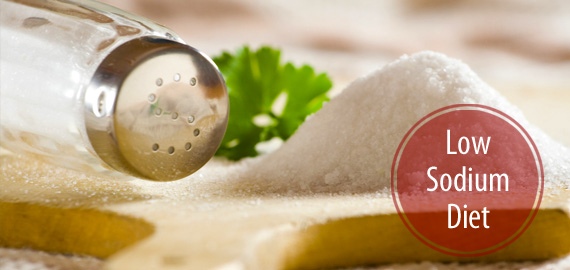It is important to limit your intake of salt to stay healthy. While many people understand the importance of reducing the amount of salt they eat, they still fail to keep it within the healthy range. That is mainly because processed foods have very high levels of sodium, and if you have packaged or processed foods in your diet, chances are you are consuming more salt than recommended. You need to understand that you cannot eliminate salt from your diet because it helps control fluid balance in the body, but you can certainly stick to a low-sodium diet to enjoy several health benefits.

Tips for Keeping a Low Sodium Diet
Eating too much sodium can cause fluid retention and affect your blood pressure at the same time; therefore, it makes sense to stick to a diet low in sodium. Here are some tips for people who want to control their intake of salt.
1. Opt for Lower-Salt Foods
When shopping for food, it is important to learn how you can opt for lower-salt foods and cut your sodium intake in a healthy way. Here are a few tips:
- Pay attention to nutrition labels when buying packaged food. You just need to read the labels and buy the ketchup, pizza, and breakfast cereal with low salt content.
- Avoid cured meats and fish because they may be laden with added salt; instead opt for reduced-salt, un-smoked versions.
- Opt for tinned veggies that contain no added salt.
- Be very careful when buying ready-made pasta sauces because they may have loads of added salt. Tomato-based sauces are usually better than cheesy sauces.
- Opt for veggies or fruit when looking for healthier snacks. Celery sticks or carrots are always better than crackers and crisps. Do not forget to read the label if you really want to have some crackers.
- Limit your intake of mustard, soy sauce, mayonnaise, pickles, and other table sauces.
2. Use Less Salt When Cooking
Instead of adding salt to food when cooking, you can try many other ways to add flavor to your cooking. Here are some salt alternatives:
- Use black pepper instead of salt. You can always try it on scrambled egg, pasta, fish, pizza, and soup.
- Make use of fresh herbs and spices to veggies, pasta dishes, and meat. You can opt for ginger, garlic, lime, and chili in stir-fries.
- Consider making your own gravy instead of using granules or cubes. You can also find some reduced-salt products to take advantage of.
- Try roasting or baking veggies, such as tomatoes, red peppers, parsnips, fennel, courgettes, and squash.
- Make sauces with the help of garlic and tomatoes.
3. Restaurant Dining Tips
It seems difficult to limit your intake of salt when ordering something in a restaurant. However, you can still use some restaurant dining tips to stick to a low sodium diet. For instance:
- It is better to opt for restaurants that do not mind preparing items as per your request.
- Consider eating less when you cannot do anything to reduce the amount of sodium in a particular dish.
- It is better to avoid broths and soups and opt for rolls, fresh bread and buttery crusts as appetizers.
- Avoid canned veggies, pickles, cured meats, olives, and bacon bits. You should also avoid cheeses, seasoned croutons, and nuts to limit your intake of salt.
- Always order salad dressings and enjoy them while eating your food.
- Opt for steamed veggies whenever possible.
- Opt for poultry, meat, or fish that include the word baked, broiled, roasted, and grilled.
- Opt for vegetable dishes and order plain noodles whenever possible.
- Avoid restaurants that do not let you order specific food.
- Say no to missed dishes and casseroles; instead, opt for sauces and gravies.
- Avoid special sauces, cheese, and condiments and opt for non-breaded and non-fried entrees.
- Opt for sherbet, fruit, plain cakes, and gelatin.
Why Is It Important to Keep a Low Sodium Diet?
While you need sodium for good health, it is important to ensure you are not getting too much of it. You need salt to maintain an electrolyte balance in your body, but too much of water or salt can disturb this balance and cause all sorts of problems.
By reducing your salt intake, you can reduce blood pressure and prevent water retention in the body, which will save you from dealing with swelling of the extremities. It also helps lower your risk of cardiovascular disease. You can improve the effectiveness of certain medications by sticking to a low sodium diet. This is especially true in case you are taking medications to treat hypertension.
Limiting your intake of salt will also lower your risk of stroke and kidney stones. You need to understand that there is a direct connection between hypertension and sodium intake. However, you need to talk to your doctor before changing your diet if you are already taking diuretics. They will tell you how much sodium you should include in your diet.
How Much Sodium Are You Supposed to Eat Per Day?
As per the 2010 Dietary Guidelines for Americans, you should not take more than 2,300mg of sodium per day. You should be lowering it to 1,500mg/day if you are African American, have hypertension, or are over age 51. The same is the case for people who have diabetes or another chronic disease. It is also important to bear in mind that a teaspoon of table salt provides you with 2,325mg of sodium, so chances are you are already taking a lot more than the recommended intake of sodium. Work with your doctor and learn to reduce your intake of salt.